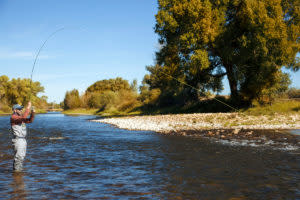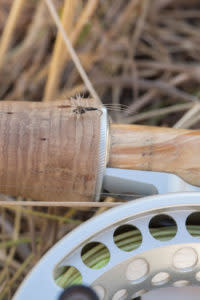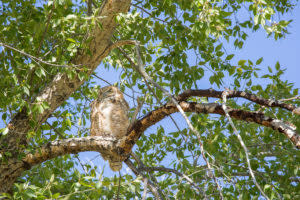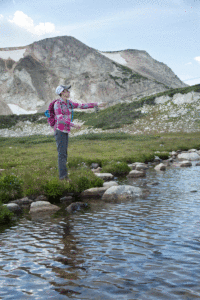 The older I get, the harder it has become to make time for fishing, especially during the summer. Summer weekends in Laramie fill up quickly with back-to-back events and activities that compete with the time I have to get out on the river.
The older I get, the harder it has become to make time for fishing, especially during the summer. Summer weekends in Laramie fill up quickly with back-to-back events and activities that compete with the time I have to get out on the river.
Fortunately, fall is my favorite time of year to fish. During this season, the decrease in our busy schedules parallels an increase in fish activity. This increase is mainly the result of changing temperatures and spawning behavior. Cooler days bring the overall water temperature back into a range that is more well-suited for trout, allowing them to feed for longer periods during the day. Brown trout also spawn in the fall, and this process generates more territorial disputes between large browns. Spawning also leads to an uptick in aggression, and therefore also in the likelihood of a trout hitting your fly.
While there are many worthy Wyoming Fall fly fishing locations near Laramie, my favorites for fall outings are the Laramie River above Woods Landing, the North Platte River at Treasure Island, and 6-Mile Gap near the Colorado border.
Regardless of where you go, below I offer five tips for making your fall fly fishing adventure a success.
Tip #1: Select the Right Flies
 This advice is true no matter what time of year you’re fishing. But what works best in the fall? The answer, of course, depends on several factors. Still, there are certain go-tos for fall fishing, such as the infamous “trico” pattern. Recently, my wife and I fished the North Platte River at Treasure Island where we were aimed at smaller fish on dry flies in the slower, more shallow sections. Given these conditions, tricos were a fine choice for us. Tricos, often called midges, are flies that emerge from late August through September. When a hatch is at its peak, the insects form cloud-like formations over the water, sometimes giving the appearance that the water is smoking.
This advice is true no matter what time of year you’re fishing. But what works best in the fall? The answer, of course, depends on several factors. Still, there are certain go-tos for fall fishing, such as the infamous “trico” pattern. Recently, my wife and I fished the North Platte River at Treasure Island where we were aimed at smaller fish on dry flies in the slower, more shallow sections. Given these conditions, tricos were a fine choice for us. Tricos, often called midges, are flies that emerge from late August through September. When a hatch is at its peak, the insects form cloud-like formations over the water, sometimes giving the appearance that the water is smoking.
Fishing tricos is a fun challenge, especially for those with a perfectionist streak. Your execution has to be spot on in order to compete with the tens of thousands of naturals swarming and floating around your fly. The challenge is especially gratifying the moment you land a big fish on your tiny trico.
My first choice for a trico pattern is called the “hackle stacker” in size #20. They are available at Four Season Anglers in Laramie. Grab a handful on your way out of town.
If you’re aimed at bigger trout, perhaps those lingering below the runs in deeper waters, then streamers should fit the bill. The “thin mint” wooly bugger is an adaptation of the famous wooly bugger and is a streamer I use frequently in the fall. The pattern consists of peacock hurl for the body and three colors (rust, black and olive) for the tail. Thin mints imitate crayfish but are versatile, meaning you can easily fish them as minnows or leeches.
In the fall, bright and flashy flies often trigger an otherwise reluctant trout to spring into action given an increased tendency toward aggression. My favorite pattern to encourage this sort of fish behavior is the articulated “goldie.”
Tip #2: Use Smaller Leader

As the water drops throughout the summer it also becomes more clear, and never is this clearness more pronounced than in the fall. While in the spring you can typically get away with fishing the thickest leader that will fit through the eyelet of your fly, in the fall the size of your leader and tippet makes all the difference. I’d suggest fishing a 5x or even 6x leader and making sure that it’s at least nine feet long.
Tip #3: Be on the Water at the Edges of the Day
 The early bird gets the worm, and the early angler, the catch.
The early bird gets the worm, and the early angler, the catch.
By late morning the vast majority of fish have stopped eating and are back in the deep water to rest until evening. This pattern of fish behavior works in conjunction with the hatching of insects and often leaves a large break in fish activity during the middle of the day. So, get your fly in the water either early in the morning or in the evening.
The mid-day break is, incidentally, the perfect time to relax on the bank for lunch. Spectacularly, a great horned owl joined us for lunch on the banks of the North Platte.
Tip #4: Dress in Layers

Fall in Wyoming is a season of extremes. Frosty mornings transform into warm, sunny days. These extremes in temperature make dressing in layers essential to remaining comfortable during your outing. I typically carry a backpack and stash it on the bank for when I need to change up my layers.
Tip #5: Fish with a View
Finding the right location to both catch fish and enjoy the scenery is key for any fall fishing trip. If you, like me, aren’t a perfect fisherman, you may spook the trout from time to time with a not-so-perfect-cast or a misstep on the bank or in the water. After these common blunders, you will be happy to have a moment to take in the beautiful hues and reflections of the fall landscape while you wait for the fish to forgive and forget.
Wyoming Fall fly fishing in the Laramie area is abundant. Make plans today!
Note: Brian and Dani Harrington are independent writers contracted by Visit Laramie. Views and opinions expressed here are their own and do not reflect those of the Albany County Tourism Board.



